When it comes to weeknight comfort food, you’d be hard-pressed to find a bigger crowd-pleaser than spatchcock chicken. Imagine the moist, tender meat of a rotisserie chicken, the gorgeously golden brown, crispy skin atop a roasted chicken, and a speedy cooking time, all wrapped up in one delicious package. It’s a dinner dream come true!
So, next time you’re craving a slice of juicy chicken, have a whole bird on hand and don’t have the time for a traditional roast, give this butterflied chicken a try. My recipe below uses just a few basic herbs and spices, but you’re welcome to season it however you wish—it’s easily customizable to whatever you have on hand. For more whole chicken recipes, try my air fryer whole chicken, instant pot whole chicken, and roasted chicken next!
Why Spatcock A Chicken?
Spatchcocking is a brilliant way to cook poultry, chicken or otherwise (see my spatchcock turkey recipe as another example). This simple method involves removing the backbone and pressing the bird flat—think of the whole chicken as a globe and the spatchcock version as a map.
By changing the shape of the whole chicken from a rounded, thick mass into one flat piece, the meat can cook more evenly and more quickly. The chicken breasts won’t dry out before the thighs are done cooking. And, since all of the skin’s surface area is exposed (instead of having half tucked against the roasting pan), all of it can crisp up and brown, yielding a richer, deeper flavor all around.
Ingredients

Whole chicken — look for a small to average-sized broiler, about 4 pounds. You can use a large chicken, but this size bird will fit on a large baking sheet well.
Fresh thyme leaves — if you don’t have fresh herbs on hand, you can use a third as much dried thyme instead. (Dried herbs are more concentrated than fresh, so you don’t need as much.)
Garlic powder, paprika, salt, & black pepper — this is my go-to basic seasoning blend for poultry. I typically use sweet paprika, but you’re welcome to experiment with either hot or smoked paprika for a bolder flavor.
Olive oil & unsalted butter — this duo of fats adds the perfect amount of richness to the meat and helps the chicken skin crisp up beautifully. No need to use your special extra virgin olive oil here; just your normal cooking oil is perfect.
How To Spatchcock Chicken
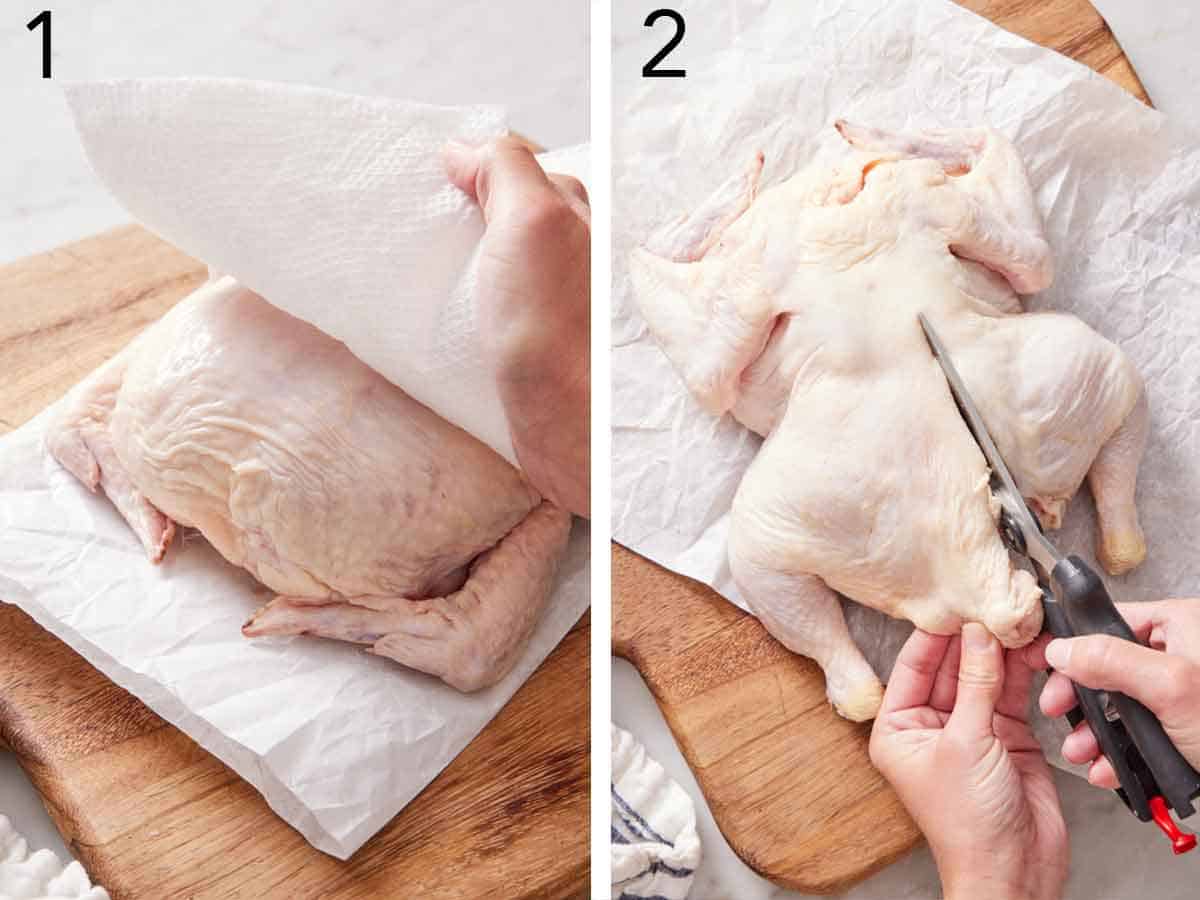
1. Pat the chicken dry with paper towels and place it on a cutting board, breast side down.
2. Use sharp kitchen shears to cut through the small bones on one side of the backbone of the chicken, staying as close to the spine as possible.

3. Repeat on the other side and remove the backbone from the bird, saving it for making chicken stock at a later time.
4. Turn the chicken over so that it is breast- and skin-side up. Place the palm of your hand between the two breasts and firmly push down to break the breast bone. (You should hear a small crack).

5. Carefully run your fingers underneath the skin of the breasts and thighs to separate it from the flesh. (Be careful not to tear the skin.)
6. Transfer the chicken breast-side up to a rimmed baking sheet lined with aluminum foil. Tuck the wings behind the breasts and point the legs inward toward each other.

7. In a small bowl, stir together the salt, thyme, garlic powder, pepper, and paprika.
8. Rub about two-thirds of the spice mixture evenly underneath the skin of the breasts and thighs, massaging it into the flesh.
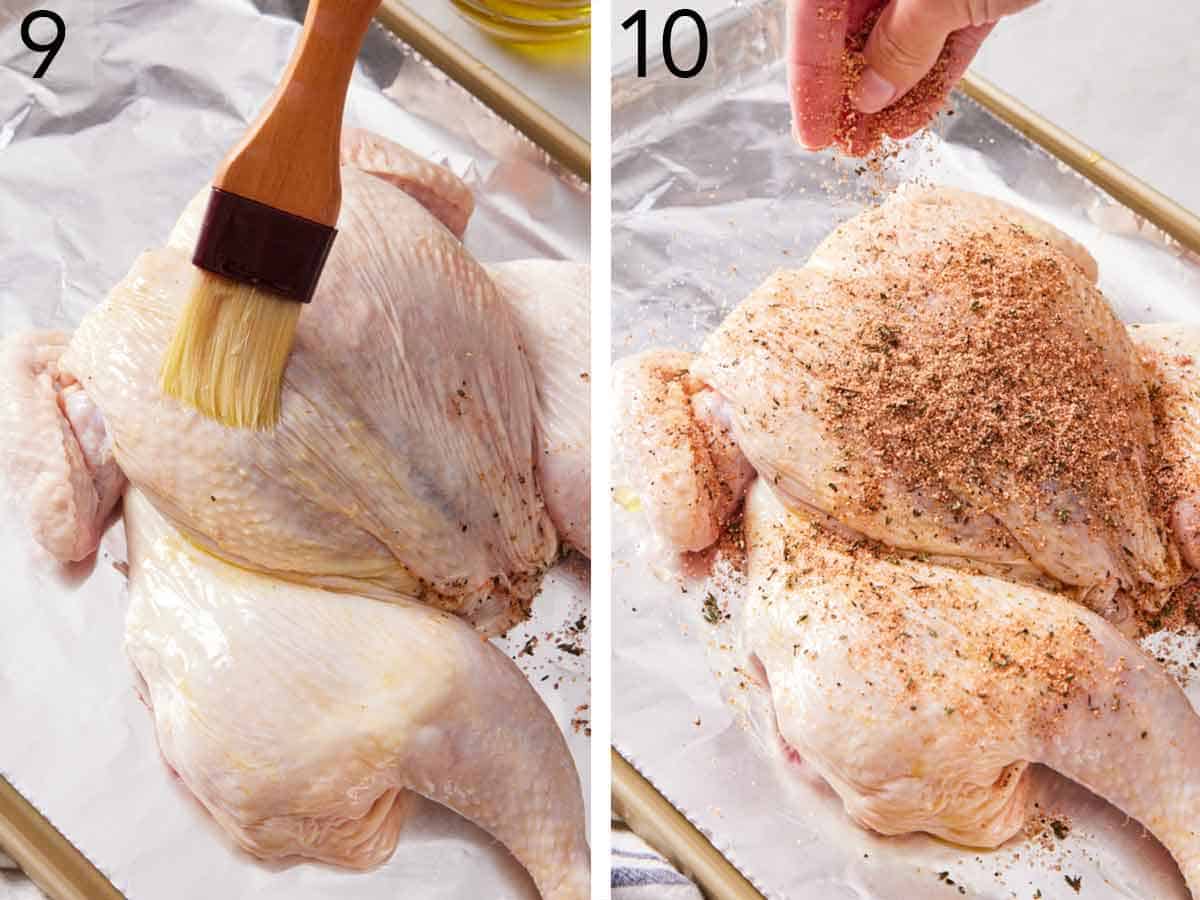
9. Brush the chicken with olive oil.
10. Sprinkle the oiled skin with the remaining one-third of the spice mixture. Rub the spices into the skin of the chicken so that they are evenly distributed. Preheat the oven to 450°F. Let the chicken rest at room temperature for 20 to 30 minutes while the oven preheats. Divide the butter into 4 pieces and place a piece on the top of each breast and thigh. Roast for 20 minutes, then decrease the temperature to 400°F. Roast for another 20 to 25 minutes until the chicken’s internal temperature reaches 165°F when a meat thermometer is stuck in the thickest part of the breast and the juices run clear. Let the chicken rest for 10 minutes before carving and serving.
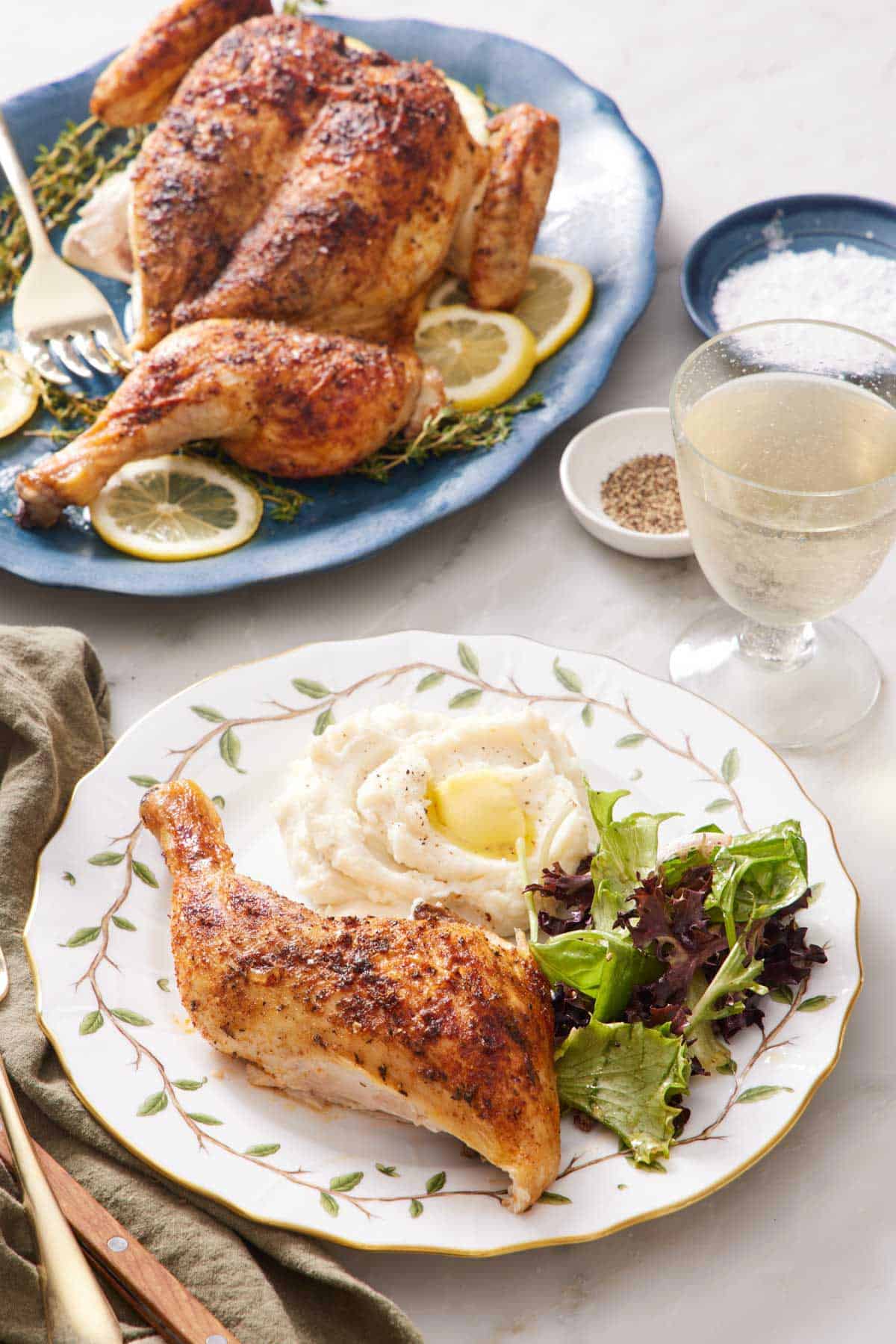
Can I Change The Seasonings?
Absolutely! This is one of those recipes you can make a dozen different ways depending on how you season it. Try adding more or different fresh herbs (like rosemary, parsley, or tarragon) or some lemon zest for brightness. You can also swap in other seasoning blends like Cajun seasoning or turkey seasoning. Or, if you have some leftover compound butter, try using cubes of that for an added layer of complexity.
How Do I Know When The Chicken Is Done?
The best way to check a chicken for doneness is with an instant-read thermometer—it should read 165ºF at the thickest portion. I usually temp a chicken in a thigh near where it meets the breast.
The cooking time will vary depending on the size of your bird, but the general rule is about 5-6 minutes per pound at 400ºF (after the first 20 minutes at 450ºF).
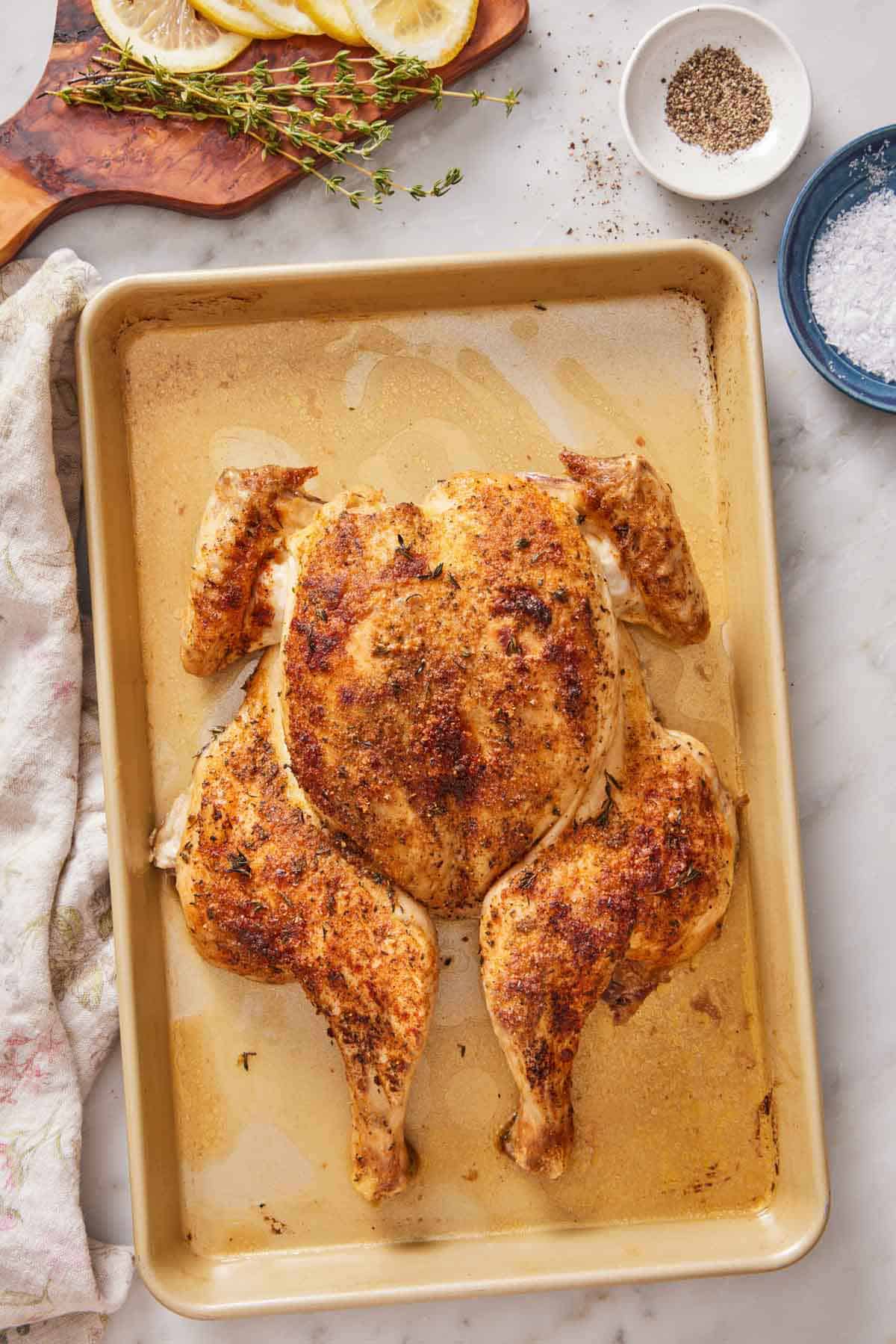
Make It A Complete One-Pan Meal
Want to cut down on dishes for the evening? I don’t blame you! To turn this sheet pan recipe into a complete meal with sides, add vegetables to the baking sheet to roast alongside the chicken.
Toss up to 3 cups of diced potatoes, carrots, onions, and/or Brussels sprouts with olive oil, salt, and pepper. After 20 minutes of roasting, scatter the vegetables around the sides of the chicken on the sheet pan. (If you have more than 3 cups of veggies, use a second sheet pan placed on the rack below your chicken.) Continue to roast for the remaining 20 – 25 minutes at 400°F.
Sides To Serve With Spatchcock Chicken
When it comes to juicy chicken, there aren’t many wrong moves in the side dish department. If I’m making lunch, I love to serve this spatchcock chicken with a green salad and lots of fresh lemon wedges.
For dinner, I generally go for a classic meat, veggie, and starch combination for a little bit of everything. My garlic mashed potatoes are my family’s favorite pairing, though baked mac and cheese and baked sweet potatoes never fail to get scarfed down, either.
To add some green veggies to the plate, try my light and crisp French green beans, air fryer broccoli, or roasted Brussels sprouts. Got picky eaters? My rich and cheesy creamed spinach recipe will convert any veggie skeptic into a vegetable connoisseur.
Pro Tips For Making This Recipe
- Pat the chicken very dry before seasoning. This will ensure perfectly crisp skin. If you have time, try removing the chicken from its packaging, patting it down with paper towels, seasoning as directed, and then returning it to the fridge uncovered for 12-24 hours for the skin to cure for even crispier results.
- Make sure your kitchen shears are very sharp. You’ll be cutting through some bones, and contrary to what you might think, dull blades are considered more dangerous than sharp ones because they require you to exert more pressure and can easily slip from their intended position.
- Don’t toss the backbone! Save it and the leftover chicken carcass for making homemade chicken stock. (You can use my turkey stock recipe as a template.)
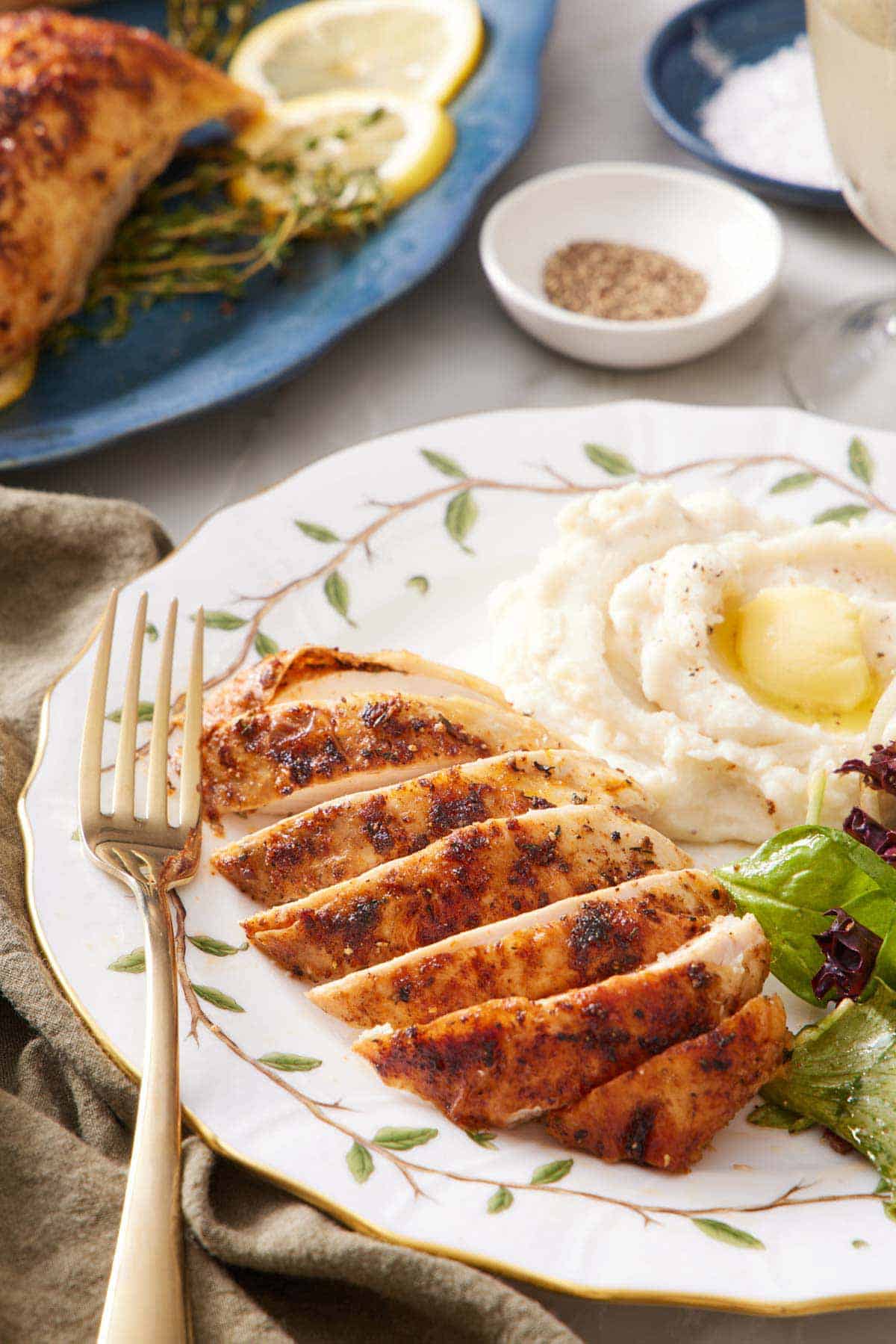
Frequently Asked Questions
Yes! Just make sure to use two sheet pans and rotate them from top to bottom halfway between the first 20-minute roasting time at 450ºF and again halfway through roasting at 400ºF so both cook and brown evenly.
Yes! This is known as “dry brining,” and it’s an excellent way to both enhance the flavor of the meat and help the skin get extra crispy. How? The salt in the seasoning will draw any excess liquid out of the skin, and keeping it uncovered in the fridge will allow that excess moisture to evaporate.
Allow any leftovers to cool, then transfer them to an airtight container or zip-top bag. They should keep well in the fridge for up to 5 days.
You can also extend the shelf-life of your cooked chicken by freezing it. I recommend butchering it into smaller pieces, wrapping them individually in plastic wrap, and then placing them in a freezer bag and pushing out as much air as possible to prevent freezer burn. Spatchcock chicken should freeze well for 2-3 months. To serve, allow the chicken to defrost in the fridge overnight, then either reheat using your preferred method or eat it cold. Leftovers can be turned into an excellent chicken salad or chicken noodle soup!
If you’ve tried this Spatchcock Chicken recipe, then don’t forget to rate it and let me know how you got on in the comments below. I love hearing from you!
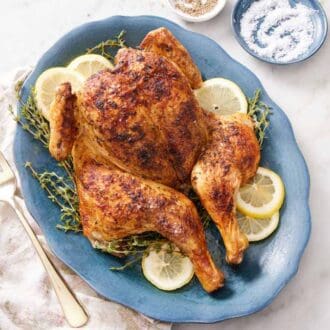
Spatchcock Chicken Recipe
Equipment
- Large rimmed baking sheet
- Paper towels
- Sharp kitchen shears
Ingredients
- 1 (4-pound) whole chicken (1.8kg)
- 1¼ teaspoons salt
- 1 teaspoon fresh thyme leaves chopped
- ½ teaspoon garlic powder
- ½ teaspoon ground black pepper
- ¼ teaspoon paprika
- 2 tablespoons olive oil
- 1 tablespoon unsalted butter
Instructions
- Pat the chicken dry with paper towels and place it on a cutting board, breast side down.
- Use sharp kitchen scissors to cut through the small bones on one side of the backbone, staying as close to the bone as possible. Repeat on the other side and remove the backbone from the chicken.
- Turn the chicken over so that it is breast-side up. Place one hand between the two breasts and firmly push down to break the breast bone. (You should hear a small crack).
- Carefully run your fingers underneath the skin of the breasts and thighs to separate it from the flesh. (Be careful not to tear the skin.) Transfer the chicken breast-side up to a rimmed baking sheet lined with aluminum foil. Tuck the wings behind the breasts and point the legs inward toward each other.
- In a small bowl, stir together the salt, thyme, garlic powder, pepper and paprika. Rub about two-thirds of the spice mixture evenly underneath the skin of the breasts and thighs, massaging it into the flesh.
- Brush the chicken with olive oil, then sprinkle it with the remaining one-third of the spice mixture. Rub the spices into the skin of the chicken so that they are evenly distributed.
- Preheat the oven to 450°F. Let the chicken rest at room temperature for 20 to 30 minutes while the oven preheats.
- Divide the butter into 4 pieces and place a piece over top of each breast and thigh.
- Roast for 20 minutes, then decrease the temperature to 400°F. Roast for another 20 to 25 minutes until the chicken’s internal temperature reaches 165°F in the thickest part of the breast and the juices run clear.
- Let the chicken rest for 10 minutes before carving and serving.
Notes
- Pat the chicken very dry before seasoning. This will ensure perfectly crisp skin. If you have time, try removing the chicken from its packaging, patting it down with paper towels, seasoning as directed, and then returning it to the fridge uncovered for 12-24 hours for the skin to cure for even crispier results.
- Make sure your kitchen shears are very sharp. You’ll be cutting through some bones, and contrary to what you might think, dull blades are considered more dangerous than sharp ones because they require you to exert more pressure and can easily slip from their intended position.
- Don’t toss the backbone! Save it and the leftover chicken carcass for making homemade chicken stock. (You can use my turkey stock recipe as a template.)



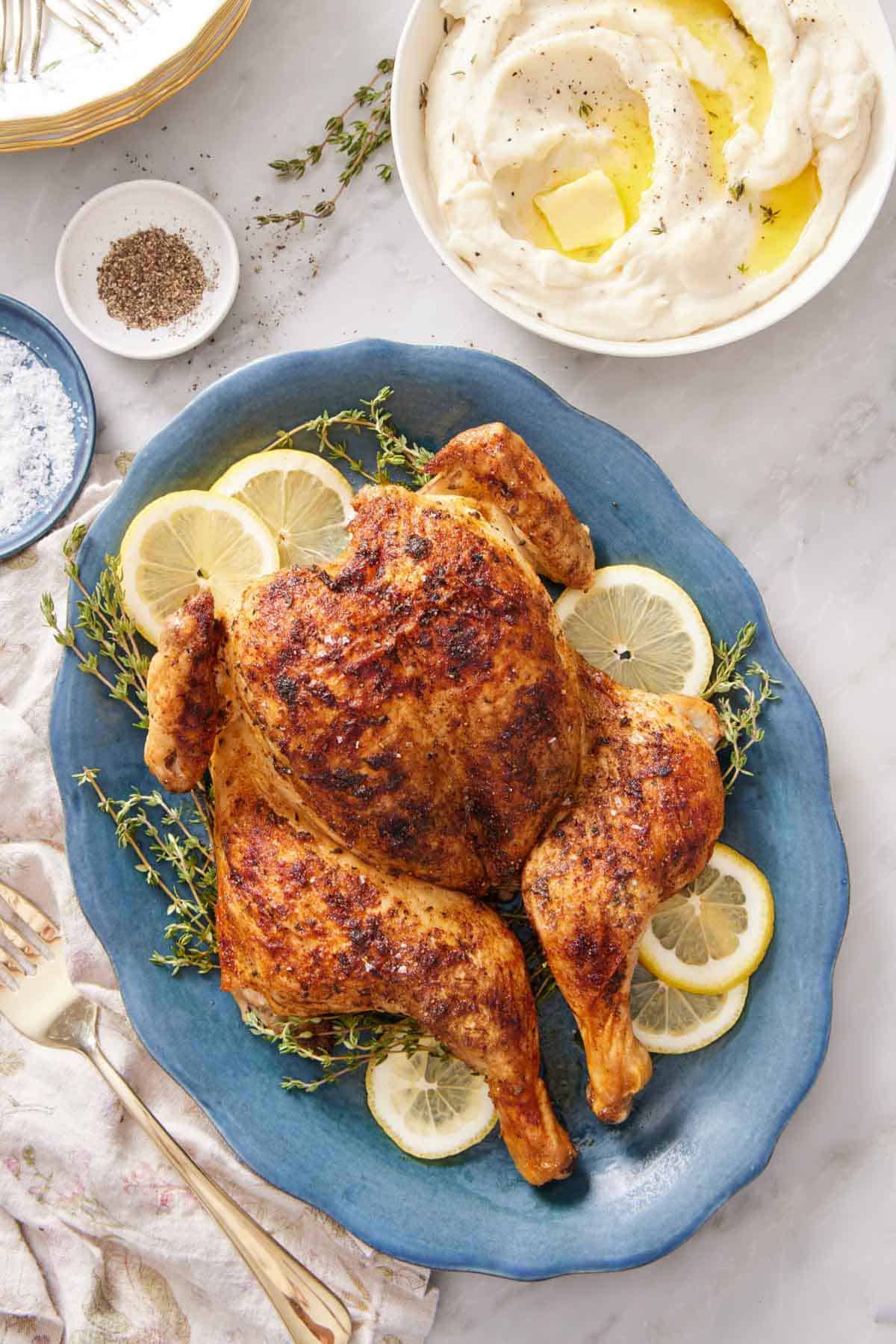








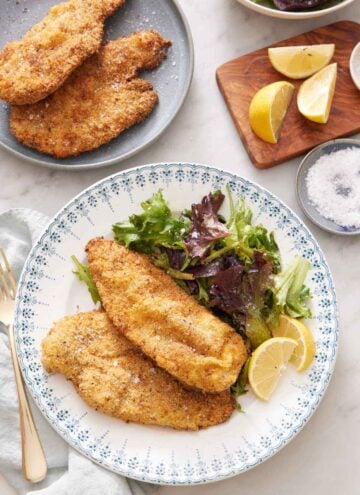

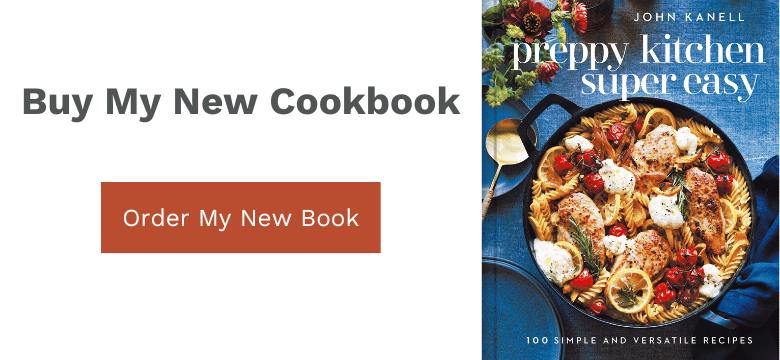
Leave a Reply